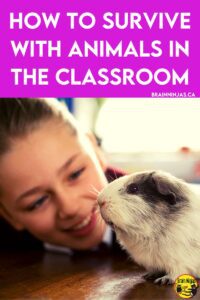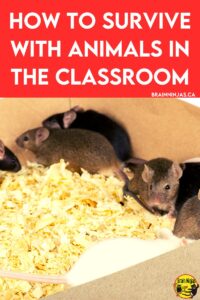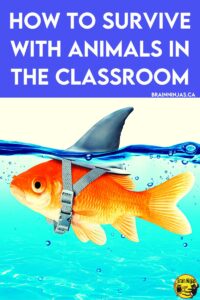
Do you have a class pet? Is it a live one or is it more of a mascot? When there are animals in the classroom, life is not boring.
We’ve had varied successes (and nightmares) over animals and insects in the classroom. We asked some of our teachers in our ninja community to share their best and worst animals in the classroom stories.
Warning: You will laugh and there is a possibility you’ll be traumatized.
Bye Bye Butterflies
As part of the Grade 2 curriculum, we raised butterflies from larva to chrysalis and then waited patiently until they emerged. Each day the students would come into class waiting to see if we had butterflies, but not yet.
Finally, we came into the classroom and found we had five butterflies…and they were loose in the classroom because we’d accidentally left the top of the tank open.
It took us an hour to catch them all and put them back in the tank. The next day we had all of our butterflies hatched. They dried their wings and we were ready to release them.
We took them outside, opened the tank and watched them flutter off. And then we watched several crows swoop down and eat them.
I had twenty-seven crying children watch their beloved butterflies be eaten by birds.
So, we went back into the classroom and talked about the circle of life. I had to send a note home to parents explaining what had happened. I’ve never gotten butterflies since.
~Submitted Anonymously

Alas Aurora!
Our class guinea pig went home with students on the weekends. Parents had to sign a consent form and agree to drive the guinea pig with her cage from school Friday and then return her Monday.
Aurora had visited over fifty different homes.
One child was so excited to take home Aurora and when his turn came he happily carried the cage to his mom’s car and waved good-bye.
Sunday night I checked my email and found several emails from his mother. The family dog had eaten the guinea pig when the family was at church in the morning. Her son was devastated, but he was even more concerned that I was going to be mad. He had told his mom I’d had the guinea pig for fifty years. That would be the world’s oldest guinea pig.
Since mid-afternoon the dog had been vomiting and she wanted to know if I wanted her to bring Aurora back to school. The dog had thrown her back up. I decided to go over to their house and pick everything up myself. I had to have a little chat explaining that I wasn’t mad and we also came up with a cover story.
Monday morning our fifth grade class had a class meeting about Aurora, but the boy and I had come to the agreement that we would just tell the class she died of old age. Everyone was pretty sad, but they seemed to understand.
Another child blurted out, “Alas Aurora, you shall be missed.”
The class burst out laughing and for the rest of the year when something didn’t go as planned or didn’t go well we would say, “Alas Aurora!”
~Submitted by Amy V

Hamster on the Loose
Picture it. It was the last day of school before winter break. The pet hamster from down the hall has gone missing overnight and now two hundred fifty primary students were running through the halls looking for it and calling it by name (as though it would hear its name and come running).
Some of the kids thought it would be a good idea to leave out hamster food for the hamster to find and then he would magically return to us. We were sweeping up hamster food (and bird seed??) for hours.
We didn’t find the hamster, but we definitely found lots of evidence of other critters that were living in the school. It was like the entire mouse population had a party over the break. We called them our free range pets.
Fast forward to three years later when that teacher moved out of the classroom. She was emptying the filing cabinet and found the poor little hamster in a slightly mummified state in the bottom drawer.
~Submitted Anonymously

Ants Aren’t Technically Animals
Early in my career I was in a long-term subbing position. On my first day, the class was quietly working away on something when suddenly I heard a vacuum turn on.
What?
Yup. A student was vacuuming up ants with the classroom vacuum.
The funniest part was that no one even looked up. Apparently, this student had been assigned “ant duty.”
It became a daily occurrence.
~Submitted Anonymously
And then He Pooped on My Leg
Do you really need the story? The title kind of sums this one up.
Birds. We invited an animal specialist from the local bird and wildlife sanctuary to bring some birds to our classroom so we could learn about them. It was an in-school style field trip that had come highly recommended.
It was also parent-teacher interviews until eight o’clock that night, so I was dressed up (which wasn’t common) and wearing my best shoes.
So my little grade ones were huddled around the table with the penguin and the owl that we got to pet. The animal expert had me put on a long glove (like the kind you would expect to wear in a slaughterhouse) and put the barn owl on my arm.
And then it started pooping…all the way down my leg. And it didn’t just poop once in one spot, it pooped like it had never pooped before. It was light I’d been sprayed with white paint-down my navy dress pants.
That is the day I learned to changed into your nice clothes after the school day. One of the kids told me he didn’t know owls pooped. He thought they just coughed up pellets and that was their “poop.”
~Submitted by Tammy B.
And Now We Know the Temperature That Kills a Fish

Our classroom was the notoriously cold classroom at the end of the hall. We’d had several plants die over the years. In fact, we’d even stopped bringing them in. Our students always had extra sweaters and even gloves at their desks. If the heat in the school was turned up, our room would still be cold while other rooms in the school were boiling. It’s part of the charm of teaching in a building over one hundred years old.
When we put our small fish tank together, we had to put in a small heater to keep the tank at the right temperature.
The kids were great about keeping an eye on the tank and did most of the maintenance.
One day right before we left for a field trip, we were checking on the fish and after adjusting the heater we plugged it back in. What we didn’t know is the circuit breaker tripped and the plug where the heater was located wasn’t working. We didn’t notice because the lights were off and we were on our way out of the classroom and school.
We returned to the classroom and noticed right away all the fish were floating on the top of the water.
One of the kids leaned over and read the temperature on the heater. Our classroom was twelve degrees Celsius and the tank was only nine.
One of the kids suggested the fish might be hibernating and that we should wait until the water warmed up before flushing them. So, we turned the heater back on, made sure it was working and left for the night.
The next morning the fish were still floating. We talked about it as a class and decided to wait a bit before getting any more fish for the classroom.
Later that day we worked on reflections from the field trip. That night when I was reading them, one student wrote under What I Learned… I learned that fish don’t like the cold.
~Submitted by Carey W.
Ear Worms
We decided to start a Red Wiggler colony of worms to help teach our students about composting. We had a bin and a local gardener taught us how to care for the worms. Every few weeks we needed to take out the worms and count them to make sure the colony was thriving.
I told my students the noise in the classroom would prevent the worms from procreating. If they had to listen to lots of noise they wouldn’t make baby worms. Wanting the colony to grow, they tried to keep the classroom quiet all the time.
We learned all about worms and their different parts. We even completed diagrams. Not one student noticed that the worms didn’t have ears and couldn’t hear.
But it sure kept the class quiet for about seven months.
~Submitted by Tara V.
Instead of having an animal inside the classroom, we try to get outside and enjoy them in their natural habitats. You might want to try our Nurture Nature Activity found in our Resource Library or we can send you a copy when you sign up for our email list.
If you like these kinds of posts (which we love to write, but don’t do very often) you might want to read Your Back to School Pep Talk.
Before You Get a Classroom Pet
We don’t tell you these stories to scare you away from ever having animals in the classroom, but to be honest, there are some things you should think about before you bring something cute and furry into your classroom.
These are the questions you need to have answered before you buy one.
What is your school or district’s policy on pets or animals in the classrooms? Some schools have policies in place due to safety or health issues. Some students have allergies, so these things need to be considered.
How will the animal be cared for? Who will take care of the animal during the day or during weekends and breaks?
Will the animal be treated well even in your classroom? Be honest about the level of noise and how your students will treat the animal. No one wants to freak out a bird or scare a rabbit because it’s too noisy.
How will you keep the animal safe? Animals get loose (well, maybe not the fish) when cages get left open or doors (we once heard about a runaway rabbit).
What will you tell the students if or when the animal dies? This is an important life lesson, but is it one that you want to talk about in your classroom?
What will happen to the animal when the school year ends? We know of one teacher who gifts the fish from the classroom tank to a family each year. Will you be taking the animal home?
Pets can be a wonderful addition to any life. If you can’t have a real one in your classroom, consider having a mascot instead. A stuffed animal, a plant or a pet rock can do the trick.
How Do We Get Stories About Animals in the Classroom?
One of the best pieces of advice was from one of our cooperating teachers who recommended keeping a journal of all the funny and special moments. This can come in handy when you have a rough day and need to be reminded of why you do this job. You can grab a copy of our teacher gratitude journal in our Resource Library or we can send you a copy when you sign up for our email list.
Write those stories down.
Do you have an animal story about your classroom? We would love to hear it! We would especially like to hear it if it’s funny or silly. Leave us a comment below or send us an email with your story!








